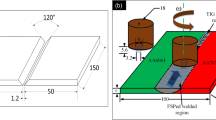Abstract
Cross wedge rolling (CWR) is one of the most effective plastic deformation methods utilized for the production of shaft parts or non-shaft preforms with refined grains and improved mechanical properties. The main goal of this work was to study the influence of CWR process parameters on the microstructure evolution and mechanical properties of a TC6 alloy and determine the suitable process parameters for a TC6 alloy blade preform fabricated with CWR. The results showed that the volume fraction of the equiaxed α phase (\( f_{\alpha \_e} \)) decreased from ~ 0.38 to ~ 0.04 by increasing the initial deformation temperature, and the elongation (El) also decreased from ~ 19.6 to ~ 11.8% because dislocation slip first started in the equiaxed grains and then dispersed into the adjacent grains. Thus, additional equiaxed grains contributed to an increased plasticity. Moreover, with an increasing area reduction, the value of \( f_{\alpha \_e} \) increased from ~ 0.14 to ~ 0.31, and the grain refinement and microstructure uniformity also increased. In addition, the El was significantly reduced by over 50%, but the ultimate tensile strength (UTS) and yield strength (YS) increased under WC (water cooling) conditions due to the precipitation of the acicular secondary α phase and pinning effect of the small equiaxed α phase. Based on the determined suitable parameters, the TC6 alloy blade preform was successfully manufactured by CWR, the microstructure was evenly distributed, and the UTS, YS and El were 1120.1 MPa, 1020.9 MPa and 15.2%, respectively, which meet the current technical requirements.













Similar content being viewed by others
References
Leyens C, Peters M. Titanium and titanium alloys: fundamentals and Applications. 1st ed. Darmstadt: betz-druck GmbH; 2003.
Huang SH, Zong YY, Shan DB. Application of thermohydrogen processing to Ti6Al4V alloy blade isothermal forging. Mater Sci Eng, A. 2013;561:17–25.
Liu YL, Du K, Zhan M, Yang H, Zhang FW. Physical modeling of blade forging. J Mater Process Technol. 2000;99:141–4.
Na YS, Yeom JT, Park NK, Lee JY. Prediction of microstructure evolution during high temperature blade forging of a Ni–Fe based superalloy, alloy 718. Met Mater Int. 2003;9:15–9.
Painter B, Shivpuri R, Altan T. Prediction of die wear during hot-extrusion of engine valves. J Mater Process Technol. 1996;59:132–43.
Huo YM, Bai Q, Wang BY, Lin JG, Zhou J. A new application of unified constitutive equations for cross wedge rolling of a high-speed railway axle steel. J Mater Process Technol. 2015;223:274–83.
Ji HC, Liu JP, Wang BY, Zhang ZR, Zhang T, Hu ZH. Numerical analysis and experiment on cross wedge rolling and forging for engine valves. J Mater Process Technol. 2015;221:233–42.
Meyer M, Stonis M, Behrens BA. Cross wedge rolling and bi-directional forging of preforms for crankshafts. Prod Eng Res Dev. 2015;9:61–71.
Behrens BA, Stonis M, Blohm T, Richter J. Investigating the effects of cross wedge rolling preforming operation and die forging with flash brakes on forging titanium hip implants. Int J Mater Form. 2018;11:67–76.
Qin DY, Guo DZ, Zheng L, Li YL. Dynamic recrystallization of Ti-5553 alloy during sub-transus thermomechanical processing: mechanisms and its role in formation of a bi-modal structure. J Alloy Compd. 2018;769:725–31.
Julien R, Velay V, Vidal V, Dahan Y, Forestier R. Characterization and modeling of forged Ti–6Al–4V Titanium alloy with microstructural considerations during quenching process. Int J Mech Sci. 2018;142–143:456–67.
Shi ZF, Guo HZ, Liu R, Wang XC, Yao ZK. Microstructure and mechanical properties of TC21 titanium alloy by near-isothermal forging. Trans Nonferr Met Soc. 2015;25:72–9.
Xu JW, Zeng WD, Sun X, Jia ZQ. Microstructure evolution during isothermal forging and subsequent heat treatment of Ti-17 alloy with a lamellar colony structure. J Alloy Compd. 2015;637:449–55.
Ansarian I, Shaeri MH, Ebrahimi M, Minarik P, Bartha K. Microstructure evolution and mechanical behaviour of severely deformed pure titanium through multi directional forging. J Alloy Compd. 2019;776:83–95.
Zhang ZX, Qu SJ, Feng AH, Hu X, Shen J. Microstructural mechanisms during multidirectional isothermal forging of as-cast Ti–6Al–4V alloy with an initial lamellar microstructure. J Alloy Compd. 2019;773:277–87.
Huo YM, Lin JG, Bai Q, Wang BY, Tang XF, Ji HC. Prediction of microstructure and ductile damage of a high-speed railway axle steel during cross wedge rolling. J Mater Process Technol. 2017;239:359–69.
Wang MT, Li XT, Du FS, Zheng YZ. A coupled thermal–mechanical and microstructural simulation of the cross wedge rolling process and experimental verification. Mater Sci Eng A. 2005;391:305–12.
Wang MT, Li XT, Du FS, Zheng YZ. Hot deformation of austenite and prediction of microstructure evolution of cross-wedge rolling. Mater Sci Eng A. 2004;379:133–40.
Li JL, Wang BY, Hang H, Fang S, Chen P, Shen JX. Unified modelling of the flow behaviour and softening mechanism of a TC6 titanium alloy during hot deformation. J Alloy Compd. 2018;748:1031–43.
Li JL, Wang BY, Qi Y, Fang S, Huang X, Chen P. Investigating the effect of the process parameters on the cross wedge rolling of TC6 alloy based on the temperature and strain rate sensitivities. Int J Adv Manuf Technol. 2019;103:2563–77.
Yang XM, Zhao ZL, Ning YQ, Guo HZ, Li H, Yuan SC, Xin SW. Microstructural evolution and mechanical property of isothermally forged BT25y titanium alloy with different double-annealing processes. Mater Sci Eng A. 2019;745:240–51.
Abbasi SM, Momeni A. Effect of hot working and post-deformation heat treatment on microstructure and tensile properties of Ti–6Al–4V alloy. Trans Nonferr Met Soc. 2011;21:1728–34.
Acknowledgements
This work was supported by China Postdoctoral Science Foundation (Grant No. 2019M660448) and was also supported by the Fundamental Research Funds for the Central Universities (Grant No. FRF-TP-19-043A1).
Author information
Authors and Affiliations
Corresponding author
Additional information
Publisher's Note
Springer Nature remains neutral with regard to jurisdictional claims in published maps and institutional affiliations.
Rights and permissions
About this article
Cite this article
Li, J., Wang, B., Fang, S. et al. Investigation of the microstructure evolution and mechanical properties of a TC6 alloy blade preform produced by cross wedge rolling. Archiv.Civ.Mech.Eng 20, 70 (2020). https://doi.org/10.1007/s43452-020-00078-2
Received:
Revised:
Accepted:
Published:
DOI: https://doi.org/10.1007/s43452-020-00078-2




